Where is Tunisia?
About Tunisia
The Land
The People
Life and Death
Health, Energy and the Environment
Education and Work
Travel, Communication and the Media






Back to the Flags of Africa page

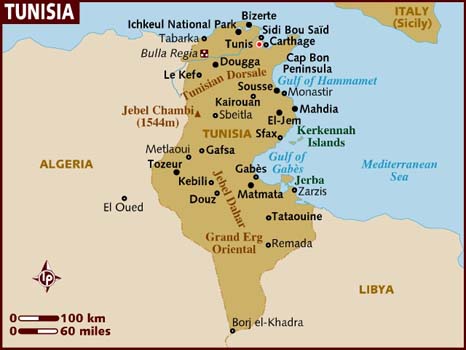


Tunisia is an above average sized country in Africa.
Tunisia borders the Mediterranean Sea.
The land is mostly mountainous in the north, a hot central plain and then dessert in the south.
The geographical coordinates for the centre of Tunisia, also known as lines of latitude and longitude, are:-
Latitude - 34 00N
Longitude - 9 00E
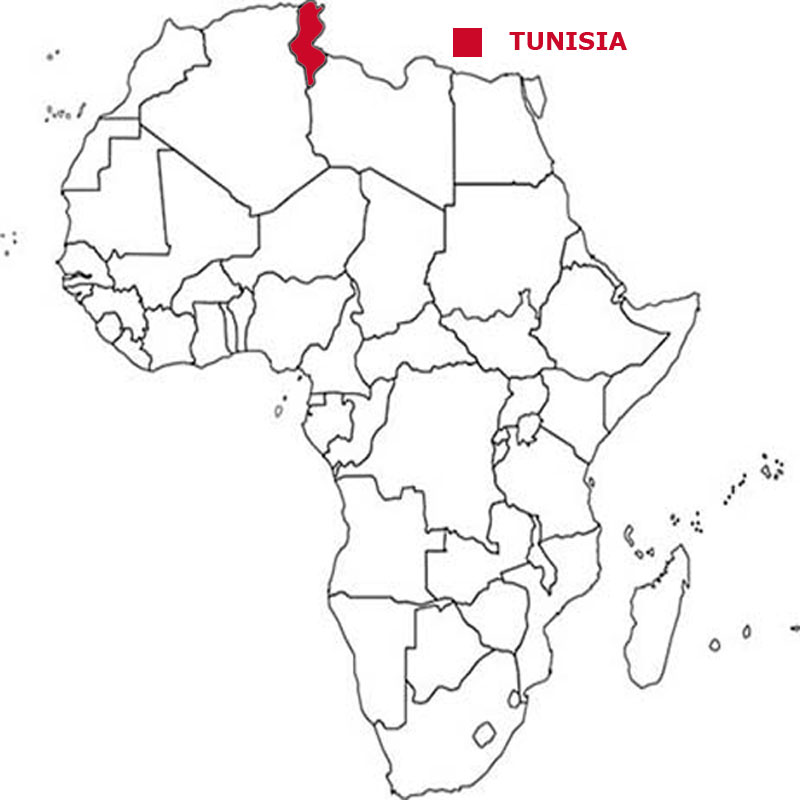

Check the weather in Tunis now.
This is the time in Tunis now
 The Tunisian flag is red with a white disk in the centre. On the disc is a red crescent nearly encircling a red five-pointed star. Red represents the blood shed by
martyrs in the struggle against oppression, white stands for peace and the crescent and star are traditional symbols of Islam.
The Tunisian flag is red with a white disk in the centre. On the disc is a red crescent nearly encircling a red five-pointed star. Red represents the blood shed by
martyrs in the struggle against oppression, white stands for peace and the crescent and star are traditional symbols of Islam.
Tunisia is a parliamentary republic with a president as head of state and a prime minister as head of the government.
In elections everyone over the age of 18 can vote except for active government security forces, people with mental disabilities and people who have served more than three months in prison for a criminal offence.
The currency in Tunisia is the Tunisian dinar.
Arabic is the official language.
Hear the National Anthem
These are the anthem words
We have already written our own history of England but are asking schools in Tunisia to provide us with a detailed history of
their own country. Check how here.
![]()
![]() Back to the top
Back to the top

The total land area of Tunisia is 155,360 sq kms which is the 36th largest in Africa.
Tunisia has lakes, rivers and canals which total 8,250 sq kms.
Tunisia has boundaries with 2 countries
- Algeria 1,034 kms
- Libya 461 kms
Tunisia has a coastline of 1,148 kms which is the 12th longest in Africa.
The highest point in Tunisia is Jebel ech Chambi at 1,544 metres.
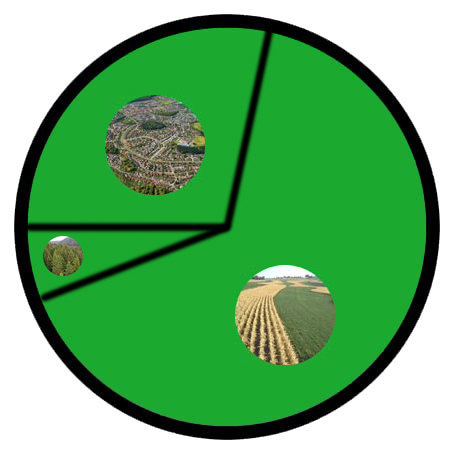

The total population of Tunisia is 11.52 million people, making it the 29th largest country in Africa by population.
Of this number 5.80 million are females and 5.72 million are males.
A person from Tunisia is called a Tunisian.
To be a citizen of Tunisia, one of your parents must be a citizen of Tunisia. It is not sufficient to be born in Tunisia. You have to live in Tunisia for
5 years before you can begin to apply for citizenship.
The largest five cities in Tunisia, by population are:-
- Tunis 693,210 people
- Sfax 277,278
- Sousse 164,123
- Kairouan 119,794
- Bizerte 115,268
 Each little Owlbut is 1 person and
the big yellow rectangle is 1 sq km. After a while you can compare countries and see which ones are the most crowded. Remember it is only an average as
more people live closer together in towns and cities than in villages out in the country.
Each little Owlbut is 1 person and
the big yellow rectangle is 1 sq km. After a while you can compare countries and see which ones are the most crowded. Remember it is only an average as
more people live closer together in towns and cities than in villages out in the country.
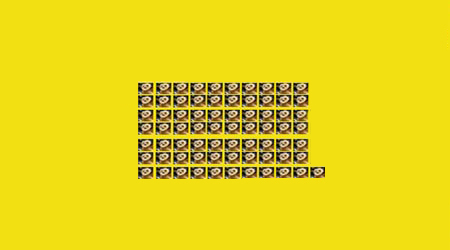
68.9% of the people live in cities or towns.

The birth rate in Tunisia is 17.4 births per 1,000 of population
The death rate in Tunisia is 6.4 deaths per 1,000 people.
Check this against the birth rate. If the death rate is higher than the birth rate then
the population will decrease unless immigrants arrive in the country.
There are 10.5 deaths of girls under 1 year per 1,000 of births and 12.8 deaths of boys.
The median age for females is 32.5 and for males is 31.5. The median age is that age which divides the population exactly in half so there are the same number
of people above the median age as below it.
We have no figures for the average age of a woman when she has her first child.
The elderly dependency ratio is 11.1. This is the number of elderly people (ages 65+) per 100 people of working age (ages 15-64).
The potential support ratio is 9.0. This is the number of working-age people (ages 15-64) per one elderly person (ages 65+). As a population ages, the potential support ratio tends to fall, meaning there are fewer potential workers to support the elderly.
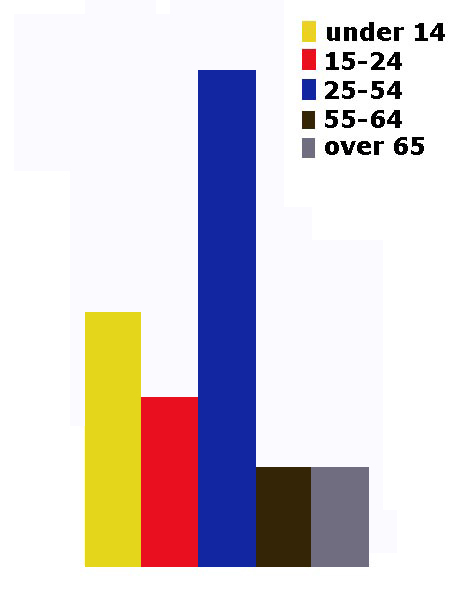
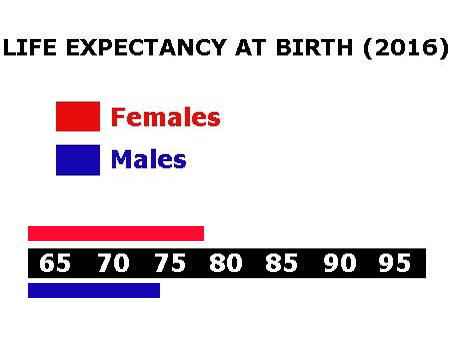

Tunisia spends 7.0% of its total income on health care.
There are 1.27 doctors per 1,000 people.
There are 2.2 hospital beds per 1,000 people.
26.9% of the population are estimated as obese.
100% of the urban population and 93.2% of the rural population have drinking water that is either piped into their home or they have access to a public tap, a protected borehole, well, spring or
protected rainwater collection facility.
97.4% of the urban population and 79.8% of the rural population have access to a flushing toilet that is connected to a sewer, a pit latrine (that is a
permanent hole in the ground that is looked after) or a composting toilet.
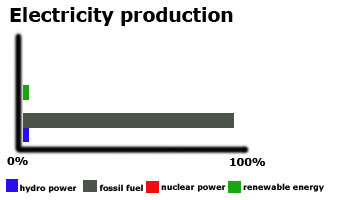
Tunisia releases 21.0 million metric tons of carbon dioxide by burning fossil fuels in the process of producing and consuming energy. This puts it as the 8th highest in Africa.

Tunisia spends 6.6% of its total income on education.
Children usually start school at age 6 in Tunisia. Primary education is for six years until age 12 and secondary education must continue till 15 but can go on to 18/19. This may be followed
by further education at a university or college.
Generally the school year consists of 3 terms and starts in the middle of September and finishes at the end of June. There is usually a 2 week
break in the middle of December and the middle of March, and a one week break in the middle of each of the terms.
74.2% of females and 89.6% of males are able to read and write by the age of 15.
34.7% of all people aged between 16 and 24 are not in work. Among females 37.7% are unemployed while with males 33.4% can't find work.
The total number of people available for work in Tunisia is 4.05 million.
 They work in the following sectors.
They work in the following sectors.
- Agriculture includes farming, fishing and forestry work
- Industry includes mining, manufacturing, construction and energy workers
- Services is everything else

There are 15 paved airports in Tunisia, which is the 16th highest number in Africa.
![]()
There are 2,173 kilometres of railways in Tunisia, the 13th longest in Africa.
![]()
There are 19,912 kilometres of roads in Tunisia, which means Tunisia is in 26th place for the most kilometres of roads in Africa.
![]()
There are 6 major national newspapers in Tunisia.
There are 14.33 million mobile phone users.
10% of the people have a fixed landline.

5.67 million people have access to the internet at home via any device (computer or mobile).


